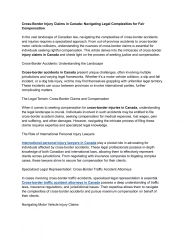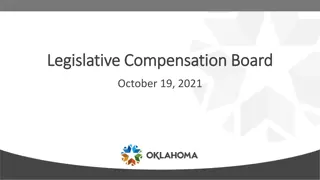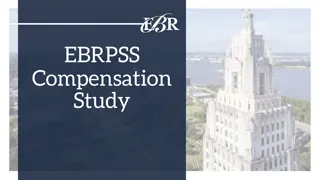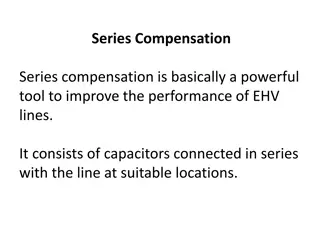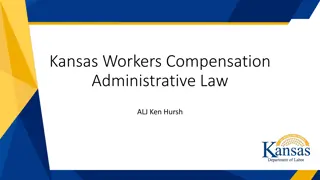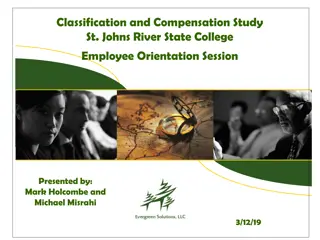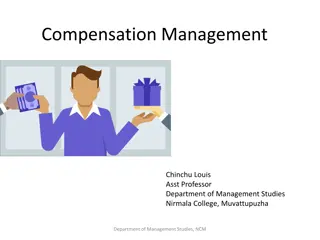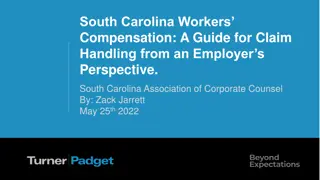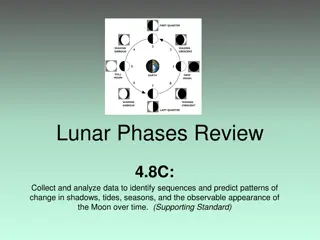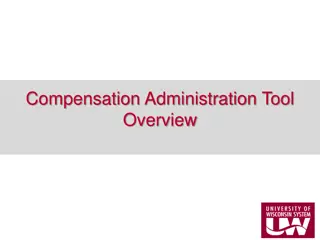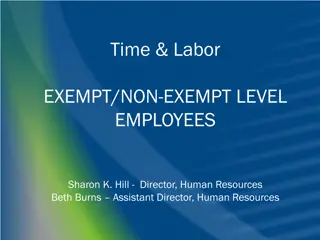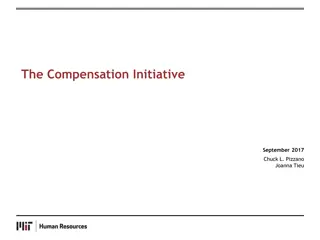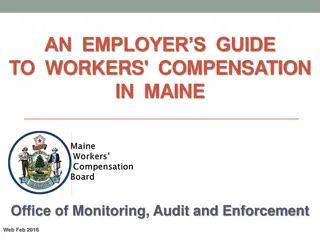Non-Represented Employee Classification & Compensation Study Phases
This study involves the development of classification specifications, salary schedule recalibration, career ladder identification, salary surveys, and implementation of new salary structures for district senior leadership and administrators managing academic programs and operations.
Download Presentation

Please find below an Image/Link to download the presentation.
The content on the website is provided AS IS for your information and personal use only. It may not be sold, licensed, or shared on other websites without obtaining consent from the author.If you encounter any issues during the download, it is possible that the publisher has removed the file from their server.
You are allowed to download the files provided on this website for personal or commercial use, subject to the condition that they are used lawfully. All files are the property of their respective owners.
The content on the website is provided AS IS for your information and personal use only. It may not be sold, licensed, or shared on other websites without obtaining consent from the author.
E N D
Presentation Transcript
Phases of the Non-Represented Employee Classification & Compensation Study Phase 1 - District Senior Leadership Development of classification specifications, definition of hierarchies, and recalibration of the salary schedule to alleviate salary compression that was identified previously Phase 2 - District Building Administrators and Licensed Administrators Managing Academic Programs and Operations Identification of career ladders, development of classification specifications, conduct salary surveys, and development of a new salary schedule. Phase 3 - Remaining Non - Represented Employees (including business operations and management) In process focusing on defining job families, developing classification specifications, identifying career ladders, and conducting salary surveys. Additionally, as part of this phase, the Division is focusing on review of the current broadband classification system and compensation structure.
NON REPRESENTED EMPLOYEE CLASSIFICATION AND COMPENSATION STUDY PRELIMINARY REPORT TO THEBOARD OF EDUCATION AND SUPERINTENDENT OF SCHOOLS TABLE OF CONTENTS Section 1 Background and Introduction . . .. 2 Section 2 Project Goals .. .. . .3 Section 3 District Classification and Compensation Practices ..5 Section 4 Classification Study Methodologies ... .7 Section 5 Classification Plan Recommendations . .. ..12 Section 6 Compensation Study Methodologies 15 Section 7 Salary Schedule Proposals . . . .16 Section 8 Compensation Philosophies ... . ...28 Section 9 Implementation Strategies and Recommendations . ... .. ..31 Section 10 Project Summary ... . ... 35
Project Goals The goal for this project is to support leadership s commitment to students, parents, caregivers, stakeholders and constituents by creating a classification and compensation plan that will facilitate the District s ability to attract and retain diverse, highly qualified employees through parity with the appropriate market (external comparability) and within the organization s relationships among/between classifications (internal equity and alignment). Staff has identified the following components as essential to meeting the project objectives: Classification review: Conduct a comprehensive evaluation of the District s Non-Represented employees classification structure and related policies and practices. Beginning with the Information Technology Job Family and working through and across all Non-Represented employee job families, develop a classification plan based on job analysis. Simultaneously review operational systems and structures for organizational efficiencies and opportunities relative to the classification structure, identify career hierarchies, promotional ladders and means to promote access and opportunities for under-represented populations reflective of the student population, as identified in the District s Affirmative Action and Equity Plans. Communicate results of study findings and develop an implementation plan with supporting procedures for operationalizing the proposed classification system. Compensation and salary schedule review: Review the existing compensation model and, based on survey research, develop and/or recommend a compensation structure and philosophy to meet the District s needs and objectives in compensation setting. Determine survey agencies based on appropriateness related to type of agency, similar jobs, geographic location, organization size and special or unique needs of the Portland Public Schools. Conduct a comprehensive compensation survey, using appropriate benchmark classifications within the organizational hierarchy. Prepare and present preliminary and final study reports of findings, recommendations and supporting documentation for consideration.
REVIEW CURRENT CLASSIFICATION & COMPENSATION PLANS Non-Represented Employee Classification & Compensation Study Process Flow Chart IDENTIFY "DESIRED STATE" Portland Public Schools Human Resources Department CONDUCT COMPREHENSIVE CLASSIFICATION STUDY PREPARE AND PRESENT PRELIMINARY REPORT WITH DISCUSSION ITEMS AND PRELIMINARY RECOMMENDATIONS GATHER ADMINISTRATION'S FEEDBACK CONDUCT COMPREHENSIVE COMPENSATION STUDY Project Scope PREPARE AND PRESENT FINAL REPORT AND RECOMMENDATIONS This flow chart identifies the project tasks and processes involved in completing this study. IMPLEMENT APPROVED ACTIONS
CRITICAL FACTORS IDENTIFIED AND CONSIDERED IN DEVELOPING THE CLASSIFICATION PLAN Classification Study Overview Collect Employee Occupational Information and Prepare Job Analysis Materials 1 Meet with Superintendent's Cabinet to Introduce Study Purpose, Process and Objectives 2 Understanding the Concept and Value of Job Analysis Meet with each Department's Leader to Introduce Study; Discuss Process, Timelines,"As-Is" and "Desired State" of Department Organization Structures 3 Hold Multiple All-Staff Department Meetings , Communications Liaison Meetings, Make-Up Meetings and One-on-One Meetings to Provide Study Orientation and Distribute Study Materials 4 Initiation of the PPS Study Collect and Review Position Description Questionnaires; Review Materials and Identify Employees for Desk Audits and/or Follow-up 5 Organizational Systems and Structures Review Conduct Desk Audits and Follow-up Inquiries 6 Prepare First Draft Class Specifications and Department Organizational Structure Chart 7 Identification of Career Hierarchies and Promotional Ladders Submit to Department Leadership for Review and Feedback; Revise as Appropriate 8 Submit to Designated Department Management for Review and Feedback; Revise as Appropriate; Schedule All-Staff Meeting for Employee Review 9 Promote Access and Opportunities for Under-Represented Populations: Hold All Staff Meeting; Distribute Draft Class Specifications for Employee Feedback 10 Revise Class Specification as Appropriate; Prepare Final Class Specifications and Organization Chart; Review and Confirm Acceptance with Department Leadership Operationalizing a Non-Discriminatory Classification Plan 11 Prepare and Present Preliminary Report of Findings and Recommendations to Superintendent of Schools and Board of Directors for Review, Discussion and Direction 12 Provide Approved Class Specifications to Employees; Initiate Compensation Study 13
COMPENSATION STUDY METHODOLOGIES RECOMMEND LONG-TERM COMPENSATION STRATEGIES AND MAINTENANCE POLICIES RECOMMEND INITIAL COMPENSATION STRATEGIES AND POLICIES DISCUSS AND DETERMINE AN ORGANIZATIONAL COMPENSATION PHILOSOPHY DETERMINE BENCHMARK CLASSIFICATIONS FOR SURVEY COMPONENTS OF THE IDEAL PPS COMPENSATION PLAN SURVEY AND ANALYZE SIMILAR PUBLIC AGENCY SALARY SCHEDULE STRUCTURES SURVEY AND ANALYZE MARKET DATA FOR SALARY SCHEDULE PLACEMENT
SALARY SCHEDULE PROPOSAL 1. Define the as-is: The District Non-Represented Employee group classification and compensation program operates under a structure known as a Broadbanding method. Broadbanding is defined as the grouping of jobs with similar duties, responsibilities and levels of accountability. Broadband classifications are broad in scope and describe the general body of work, not the specific duties that belong to specific jobs included within a particular classification or job family series. In a broadband compensation system, all jobs within the organization fit within a broadly defined structure for each pay grade, allowing for compensation advancement within grade instead of through a more traditional approach of career ladder promotions. This compensation method creates fewer pay ranges and they vary, with most literature identifying each range as typically 100 percent difference from minimum to maximum. 2015 - 2016 NON REPRESENTED EMPLOYEE 260 DAY SALARY SCHEDULE STEP 1 STEP 2 STEP 3 STEP 4 STEP 5 STEP 6 STEP 7 STEP 8 STEP 9 STEP 10 PAY GRADE F EIT E D C B A $82,586 $75,344 $71,867 $61,590 $52,378 $42,478 $35,020 $85,726 $78,170 $74,598 $64,176 $54,972 $44,517 $36,840 $88,983 $81,101 $77,433 $66,871 $57,089 $46,889 $38,756 $92,364 $84,142 $80,376 $69,876 $59,600 $48,893 $40,945 $95,874 $87,297 $83,430 $72,607 $62,223 $51,239 $42,941 $99,518 $103,301 $107,224 $111,298 $113,858 $90,570 $93,968 $95,847 $86,600 $89,890 $93,307 $75,657 $78,834 $82,145 $64,960 $67,818 $70,802 $53,807 $56,277 $58,978 $45,319 $47,467 $49,936 $97,764 $100,012 $95,173 $83,788 $72,218 $60,157 $50,935 $97,363 $85,716 $73,879 $61,541 $52,106
PPS Broadband Salary Schedule Definitions of Bands PAY GRADE & ASSOCIATED TITLE(s) DEFINITION F Reports to a chief or director. Responsible for direction and management of a group of staff and/or program area. Holds decision making authority and accountability for effective operations of an operational area or program. Responsible for the design and implementation of new initiatives, programs and business processes under the guidance of a chief or director. Select budget authority in some cases. Requires significant cross-functional leadership and process management skills. Requires deep technical know-how in an operational or academic area or areas. Assistant Director; Program Director No description. EIT Peoplesoft E Generally reports to assistant director or director. Responsible for management of a group of staff and/or program area. Makes strategic and operational recommendations regarding new initiatives, programs and business processes. Responsible for the design implementation of new programs and initiatives to support continuous improvement and accountable for effective operation of programs and business processes. May hold budget authority. Has independent operational decision making authority within a defined range, under the guidance of a director and/or chief. Requires significant cross-functional collaboration and project management. Requires deep technical expertise, management and experience in an operational or program area or areas. Senior Manager; Senior Program Manager Reports to a senior manager or assistant director/director. Responsible for the management of a group of staff or for the administration of a program area or is the technical lead for a specific functional area. Accountable for the smooth operation of processes, design and implementation of new initiatives, programs and business processes under the guidance of a director or senior manager. Requires cross-functional collaboration and project management. Requires deep technical expertise in an operational or program area, project management skills and experience managing people. May require specific accreditation or credentials. D Manager; Program Manager; Functional Lead; Senior Analyst Generally reports to a manager, senior manager or administrator. Provides analytical support to a key operational area and/or oversees and coordinates the activities of a program or other staff. Generally responsible for reporting and responding to requests for information with respect to program or area. May provide training to other staff. Generally supports the smooth operation of business processes, coordinates the implementation of new initiatives, programs and processes under the direction and guidance of a functional lead, manager or administrator. Requires strong technical expertise/experience in an operational or program area. May require specific accreditation or credentials. May have limited supervisory responsibility. C Analyst; Coordinator Reports to a manager or administrator. Provides process support in an operational area, responsible for completing transactions, responding to inquiries, and providing high level of customer service, under the direction and guidance of direct supervisor. Required to understand and follow standard operating procedures and demonstrate technical skills in program or operational area. May be responsible for interpreting policy and making decisions within a defined set of guidelines. May lead special projects or be responsible for overseeing a defined program and/or the design and implementation of new initiatives. Requires specific expertise/experience in an operational or program area. Generally has no supervisory responsibility. B Sr. Specialist Generally reports to a manager or administrator. Provides process and transactional support in an operational or program area, responsible for accurate completion of transactions, responding to inquiries, and providing high level of customer service, under the direction and guidance of direct supervisor. Required to understand and follow standard operating procedures and demonstrate technical skills in program or operational area. May participate in various projects or the development of new initiatives, or generate reports. May require some specific experience in an operational or program area. Generally does not involve supervisory responsibility. A Specialist
Challenges with the Current Classification Structure There are no historical District records or memories indicating that there has been a comprehensive classification study using a job analysis methodology for Non-Represented employee assignments. Prior to existence of the Classification and Compensation division of Human Resources, job descriptions were typically created only at the time of a vacancy and used as the template from which to initiate a recruitment. Each hiring authority determined the job title and defined the duties to align with the described Levels of Responsibility used in conjunction with the A F salary schedule pay grades. Over time, this practice has created an inconsistent standard for defining jobs, with a proliferation of single-incumbent positions, all carrying unique working titles and niche duties and responsibilities that tend to align more with an individuals expertise than with a defined scope of work. The very nature of Broadbanding is to create both broad definitions of criteria and a wide salary range of salary steps within each band. Because of the nature of Broadbanding, multiple, completely unrelated jobs are placed in the same pay grade band, with little rationale to indicate how the pay grade was determined. The current seven-band classification system does not recognize professional hierarchies (excluding management). This model does not recognize differences in scope/level of work performed in each of the business professions and eliminates professional staff career ladders and promotional opportunities. The current classification structure does not consider market comparisons for salary placement.
COMPENSATION STUDY METHODOLOGIES RECOMMEND LONG-TERM COMPENSATION STRATEGIES AND MAINTENANCE POLICIES RECOMMEND INITIAL COMPENSATION STRATEGIES AND POLICIES DISCUSS AND DETERMINE AN ORGANIZATIONAL COMPENSATION PHILOSOPHY DETERMINE BENCHMARK CLASSIFICATIONS FOR SURVEY COMPONENTS OF THE IDEAL PPS COMPENSATION PLAN SURVEY AND ANALYZE SIMILAR PUBLIC AGENCY SALARY SCHEDULE STRUCTURES SURVEY AND ANALYZE MARKET DATA FOR SALARY SCHEDULE PLACEMENT
COMPENSATION STUDY METHODOLOGIES COMPONENTS OF THE IDEAL PPS COMPENSATION PLAN SURVEY AND ANALYZE SIMILAR PUBLIC AGENCY SALARY SCHEDULE STRUCTURES
SALARY SCHEDULE STRUCTURE - PPS 2015 - 2016 NON REPRESENTED EMPLOYEE 260 DAY SALARY SCHEDULE WITH ALL FACTORS COMBINED STEP 1 STEP 2 STEP 3 STEP 4 STEP 5 STEP 6 STEP 7 STEP 8 STEP 9 STEP 10 AVERAGE TOTAL % FROM # EE'S PER BAND % FROM MIN TO MAX (as of 2/1/16) MIN TO MAX (Band Steps 1 -10) PAY GRADE F $82,586 $85,726 $88,983 $92,364 $95,874 $99,518 $103,301 $107,224 $111,298 $113,858 $39.70 $41.21 $42.78 $44.41 $46.09 3.80% 3.80% 3.80% 3.80% $47.85 3.80% $49.66 3.80% $51.55 3.80% $53.51 3.80% $54.74 2.30% HOURLY RATE 31 3.63% 37.866% % ABOVE PREVIOUS STEPS 9.61% 9.67% 9.72% 9.77% 9.83% 9.88% 9.93% 11.87% 13.84% 13.84% % ABOVE GRADE EIT EIT $75,344 $78,170 $81,101 $84,142 $87,297 $90,570 $36.22 $37.58 $38.99 3.75% 3.75% $93,968 $45.18 3.75% $95,847 $46.08 2.00% $97,764 $100,012 $47.00 2.00% $40.45 3.75% $41.97 3.75% $43.54 3.75% $48.08 2.30% HOURLY RATE 2 3.20% 32.740% % ABOVE PREVIOUS STEPS 4.84% 4.79% 4.74% 4.69% 4.64% 4.58% 4.54% 2.72% 2.72% 2.72% % ABOVE GRADE E E $71,867 $74,598 $77,433 $80,376 $83,430 $86,600 $34.55 $35.86 $37.23 3.80% 3.80% $89,890 $43.22 3.80% $93,307 $44.86 3.80% $95,173 $45.76 2.00% $97,363 $46.81 2.30% $38.64 3.80% $40.11 3.80% $41.63 3.80% HOURLY RATE 37 3.43% 35.477% % ABOVE PREVIOUS STEPS 16.69% 16.24% 15.79% 15.03% 14.91% 14.46% 14.02% 13.59% 13.59% 13.59% % ABOVE GRADE D D $61,590 $64,176 $66,871 $69,876 $72,607 $75,657 $29.61 $30.85 $32.15 4.20% 4.20% $78,834 $37.90 4.20% $82,145 $39.49 4.20% $83,788 $40.28 2.00% $85,716 $41.21 2.30% $33.59 4.49% $34.91 3.91% $36.37 4.20% HOURLY RATE 97 3.74% 39.172% % ABOVE PREVIOUS STEPS 17.59% 16.74% 17.13% 17.24% 16.69% 16.47% 16.24% 16.02% 16.02% 16.02% % ABOVE GRADE C C $52,378 $54,972 $57,089 $59,600 $62,223 $64,960 $25.18 $26.43 $27.45 4.95% 3.85% $67,818 $32.60 4.40% $70,802 $34.04 4.40% $72,218 $34.72 2.00% $73,879 $35.52 2.30% $28.65 4.40% $29.91 4.40% $31.23 4.40% HOURLY RATE 114 3.90% 41.050% % ABOVE PREVIOUS STEPS 23.31% 23.49% 21.75% 21.90% 21.44% 20.73% 20.51% 20.05% 20.05% 20.05% % ABOVE GRADE B B $42,478 $44,517 $46,889 $48,893 $51,239 $53,807 $20.42 $21.40 $22.54 4.80% 5.33% $56,277 $27.06 4.59% $58,978 $28.35 4.80% $60,157 $28.92 2.00% $61,541 $29.59 2.30% $23.51 4.27% $24.63 4.80% $25.87 5.01% HOURLY RATE 47 4.21% 44.877% % ABOVE PREVIOUS STEPS 21.30% 20.84% 20.99% 19.41% 19.32% 18.73% 18.56% 18.11% 18.11% 18.11% % ABOVE GRADE A A $35,020 $36,840 $38,756 $40,945 $42,941 $45,319 $16.84 $17.71 $18.63 $47,467 $22.82 $49,936 $24.01 $50,935 $24.49 $52,106 $25.05 $19.69 $20.64 $21.79 HOURLY RATE 24 5.20% 5.20% 5.65% 4.87% 5.54% 4.74% 5.20% 2.00% 2.30% 4.52% 48.789% % ABOVE PREVIOUS STEPS 352 n=
SURVEY AND ANALYZE SIMILAR PUBLIC AGENCY SALARY SCHEDULE STRUCTURES SALARY SCHEDULE STRUCTURE - SURVEY FINDINGS NUMBER OF SALARY SCHEDULE STEPS # OF STEPS # SCHEDULES 21 20 18 15 13 11 10 9 8 7 6 5 4 3 MIN/MAX (NO STEPS) 1 1 1 2 3 2 1 4 2 7 3 5 1 1 FIXED % BETWEEN GRADES % 9 7.5 5 4 # SCHEDULES 1 1 11 1 10 Survey trends indicate that half of the reviewed schedules maintained a fixed percentage between grades, with 2.5% and 5.0% tending to be the typical spreads. PPS=10 Of the 48 salary schedules reviewed, 71% are Step- based, 25% are Minimum- to-Maximum spread based and the remaining 4% are single-position (position- specific). 2.5 ** rounded to nearest 0.5% # FIXED GRADE % 24 VARIABLE BY GRADE 19 PPS POSITION SPECIFIC 5 12 1 1 FLAT RATE (NO STEPS) % SCHEDULES WITH FIXED GRADES 50% POSITION SPECIFIC n=48 % WITH STEPS 71% 34 # WITH STEPS n=48
SURVEY AND ANALYZE SIMILAR PUBLIC AGENCY SALARY SCHEDULE STRUCTURES SALARY SCHEDULE STRUCTURE - SURVEY FINDINGS SURVEY - FIXED AVERAGE % BETWEEN STEPS** % # OF SCHEDULES 5.0 4.0 3.0 2.5 2.0 1.5 8 2 7 5 1 2 PPS falls within the Variable range, with each grade holding a different minimum-to- maximum progression percentage. **rounded to the nearest 0.5% Survey trends identify the typical fixed minimum-to- maximum range to fall somewhere between 20% - 40%, with the heaviest concentration between 25% - 35% from min-to-max range. # FIXED STEP % 25 VARIABLE BY GRADE 9 PPS POSITION SPECIFIC 2 MIN - MAX ONLY; NO STEPS 12 % FIXED STEPS (excludes min/max, no step schedules) 71% n=48 Survey analysis indicated that 71% of the schedules reviewed identified consistent step-to -step, percentage progression, with typical spreads of 2.5%, 3.0% and 5.0% as the most frequently identified adjustments.
OREGON/WASHINGTON COMPARABLE "A-F" POSITIONS MAXIMUM SALARIES IDENTIFIED ON SALARY SCHEDULES SURVEY AND ANALYZE SIMILAR PUBLIC AGENCY SALARY SCHEDULE STRUCTURES LOCAL AGENCY SALARY SCHEDULE SURVEY OF MAXIMUM RATES FOR COMPARABLE LEVELS TO PPS (PAY GRADE F ) SURVEY AND ANALYZE SIMILAR PUBLIC AGENCY SALARY SCHEDULE STRUCTURES ANNUAL SALARY** AGENCY $159,260 $153,660 $151,149 $142,397 $139,502 $137,568 $135,595 $132,636 $130,509 $129,313 $128,736 $128,294 $128,244 $128,046 $126,276 $124,164 $123,996 $123,812 $122,471 $122,447 $121,375 $116,807 $115,299 $113,314 $108,553 $105,581 Portland Metro State of Oregon Portland Community College City of Portland Oregon State University Oregon City Seattle Public Schools City of Vancouver Multnomah County City of Lake Oswego Clark County Marion County Washington County Clackamas County City of Tigard City of Gresham City of Beaverton Gresham - Barlow School District Eugene School District Mt. Hood Community College City of Hillsboro David Douglas School District Hillsboro School District Canby School District Parkrose Schools City of Milwaukie PPS $113,838 n= 26; 22 not in area or unable to identify comparablity ** rates do not include PERS Pick-up
COMPENSATION STUDY METHODOLOGIES DISCUSS AND DETERMINE AN ORGANIZATIONAL COMPENSATION PHILOSOPHY COMPONENTS OF THE IDEAL PPS COMPENSATION PLAN SURVEY AND ANALYZE SIMILAR PUBLIC AGENCY SALARY SCHEDULE STRUCTURES
Defining a Compensation Philosophy: A thoughtfully executed compensation philosophy should be one which: Attracts high-quality and diverse candidates for employment; Rewards and retains qualified employees; Provides a fair and consistent framework for assigning pay grades to jobs; Maintains the salary structure at market competitiveness; Ensures fair and consistent pay practices; Complies with applicable laws and regulations; Operates within the constraints of fiscal resources; Inspires employee excellence. While the District has not adopted a formal compensation philosophy, it has clearly identified and adopted a number of values and expectations surrounding its employees and stakeholders: Board Policy 0.10.010-P Strategic Plan : Core Values Board Policy 5.10.025-P Affirmative Action Board Policy 5.20.010-P District Employment Practices
Defining a Market Position The Society for Human Resources Management (SHRM) provides an excellent discussion on different market position strategies and asks thought-provoking questions to help guide decision-makers in setting a compensation philosophy: Compensation s Role in Human Resource Strategy Where does the organization want to be in terms of market competitiveness? Does the compensation system match the organization s overall objectives? In other words, how does the compensation strategy complement other HR initiatives? For example, if quality, experience and a sophisticated skill set are an organization s strategic advantages, then it will not be successful hiring employees significantly below the market rate for that position. In this competitive job market, it is important to be aware of the organization s competing firms. An organization can lead, meet or lag the market. Lag the Market An organization may choose to offer a compensation package that is valued less than packages offered for a similar job in the labor market. An employer with a lag the market philosophy is likely to be at the back of the line when it comes to hiring and retaining employees, especially those with special skills. Meet the Market This is the most common compensation strategy. This level of competitiveness occurs when an organization s compensation strategy is equal to the labor market for the same position. Lead the Market The lead the market pay strategy can be defined as a total compensation package that is above the labor market for a similar position. This strategy may occur because an organization believes that by paying more, it will receive more experienced employees for the same position. Overall Policy Consideration A consideration when developing the District s compensation philosophy - economic conditions can change rapidly, particularly when it comes to public agency funding. We suggest that any statement include language such as, whenever possible , our aspirations are or similar language which acknowledges financial pressures in downward economies.
COMPENSATION STUDY METHODOLOGIES RECOMMEND INITIAL COMPENSATION STRATEGIES AND POLICIES DISCUSS AND DETERMINE AN ORGANIZATIONAL COMPENSATION PHILOSOPHY COMPONENTS OF THE IDEAL PPS COMPENSATION PLAN SURVEY AND ANALYZE SIMILAR PUBLIC AGENCY SALARY SCHEDULE STRUCTURES
ANNUAL RATES STEP 1 STEP 2 STEP 3 STEP 4 STEP 5 STEP 6 STEP 7 Grade 46 $106,834 $110,039 $113,340 $116,740 $120,243 $123,850 $127,565 45 $104,228 $107,355 $110,576 $113,893 $117,310 $120,829 $124,454 44 $101,686 $104,737 $107,879 $111,115 $114,449 $117,882 $121,419 43 $99,206 $102,182 $105,248 $108,405 $111,657 $115,007 $118,457 42 $96,786 $99,679 $102,670 $105,750 $108,922 $112,190 $115,556 41 $94,426 $97,258 $100,176 $103,181 $106,277 $109,465 $112,749 40 $92,123 $94,886 $97,733 $100,665 $103,685 $106,795 $109,999 39 $89,876 $92,572 $95,349 $98,210 $101,156 $104,191 $107,316 38 $87,684 $90,314 $93,024 $95,814 $98,689 $101,649 $104,699 37 $85,545 $88,111 $90,755 $93,477 $96,282 $99,170 $102,145 PROPOSED 2016 - 2017 NON-REPRESENTED MANAGEMENT AND PROFESSIONAL EMPLOYEES SALARY SCHEDULE 36 $83,459 $85,962 $88,541 $91,197 $93,933 $96,751 $99,654 35 $81,423 $83,866 $86,382 $88,973 $91,642 $94,392 $97,223 34 $79,437 $81,820 $84,275 $86,803 $89,407 $92,089 $94,852 33 $77,500 $79,825 $82,219 $84,686 $87,226 $89,843 $92,538 32 $75,609 $77,878 $80,214 $82,620 $85,099 $87,652 $90,281 31 $73,765 $75,978 $78,257 $80,605 $83,023 $85,514 $88,079 30 $71,966 $74,125 $76,349 $78,639 $80,998 $83,428 $85,931 29 $70,211 $72,317 $74,487 $76,721 $79,023 $81,393 $83,835 28 $68,498 $70,553 $72,670 $74,850 $77,095 $79,408 $81,791 27 $66,828 $68,832 $70,897 $73,024 $75,215 $77,472 $79,796 26 $65,198 $67,154 $69,168 $71,243 $73,381 $75,582 $77,849 25 $63,607 $65,516 $67,481 $69,506 $71,591 $73,738 $75,951 24 $62,056 $63,918 $65,835 $67,810 $69,845 $71,940 $74,098 23 $60,543 $62,359 $64,230 $66,156 $68,141 $70,185 $72,291 22 $59,066 $60,838 $62,663 $64,543 $66,479 $68,474 $70,528 21 $57,625 $59,354 $61,135 $62,969 $64,858 $66,803 $68,808 20 $56,220 $57,906 $59,644 $61,433 $63,276 $65,174 $67,129 19 $54,849 $56,494 $58,189 $59,934 $61,732 $63,584 $65,492 18 $53,511 $55,116 $56,770 $58,473 $60,227 $62,034 $63,895 17 $52,206 $53,772 $55,385 $57,046 $58,758 $60,521 $62,336 ( 46 Pay Grades; 7 steps; 2.5% between grades; 3% between steps; 19.40% spread from range min/max ) Ranges are mapped around current 2016-2017 Non-Rep Employee Salary Schedule maximum "F 10" rate of $115,566 16 $50,932 $52,460 $54,034 $55,655 $57,325 $59,045 $60,816 15 $49,690 $51,181 $52,716 $54,298 $55,927 $57,604 $59,333 14 $48,478 $49,932 $51,430 $52,973 $54,563 $56,199 $57,885 13 $47,296 $48,715 $50,176 $51,681 $53,232 $54,829 $56,474 12 $46,142 $47,526 $48,952 $50,421 $51,933 $53,491 $55,096 11 $45,017 $46,367 $47,758 $49,191 $50,667 $52,187 $53,752 10 $43,919 $45,236 $46,593 $47,991 $49,431 $50,914 $52,441 9 $42,848 $44,133 $45,457 $46,821 $48,225 $49,672 $51,162 8 $41,803 $43,057 $44,348 $45,679 $47,049 $48,461 $49,914 7 $40,783 $42,006 $43,267 $44,565 $45,902 $47,279 $48,697 6 $39,788 $40,982 $42,211 $43,478 $44,782 $46,125 $47,509 5 $38,818 $39,982 $41,182 $42,417 $43,690 $45,000 $46,350 4 $37,871 $39,007 $40,177 $41,383 $42,624 $43,903 $45,220 3 $36,947 $38,056 $39,197 $40,373 $41,585 $42,832 $44,117 2 $36,046 $37,128 $38,241 $39,389 $40,570 $41,787 $43,041 1 $35,167 $36,222 $37,309 $38,428 $39,581 $40,768 $41,991 Grade STEP 1 STEP 2 STEP 3 STEP 4 STEP 5 STEP 6 STEP 7 (3% BETWEEN STEPS; 2.5% BETWEEN GRADES; 19.40 % RANGE FROM MINIMUM TO MAXIMUM)
COMPENSATION STUDY METHODOLOGIES RECOMMEND LONG-TERM COMPENSATION STRATEGIES AND MAINTENANCE POLICIES RECOMMEND INITIAL COMPENSATION STRATEGIES AND POLICIES DISCUSS AND DETERMINE AN ORGANIZATIONAL COMPENSATION PHILOSOPHY COMPONENTS OF THE IDEAL PPS COMPENSATION PLAN SURVEY AND ANALYZE SIMILAR PUBLIC AGENCY SALARY SCHEDULE STRUCTURES
IMPLEMENTATION STRATEGIES AND RECOMMENDATIONS Consideration of Financial Impacts: The most obvious issue that should be addressed is the financial impact of implementation costs. In order to determine the cost of implementing any adjustments, staff will need indication of which pay philosophy would be supported by the District. We will, however, outline the process we are recommending for implementation, which we support at any salary schedule and pay philosophy. Implementation Proposal: Phase I: 2016 - 2017 We recommend initial placement in the appropriate pay grade on the new salary schedule at the step closest to, but not less than, 3% above the 2015-2016 salary schedule. We recommend that all green-circled positions should be brought to at least the minimum of the appropriate pay grade. We recommend that all red-circled positions should be frozen at the employee s current rate of pay until such time as the salary schedule and/or market position adjustments bring their classification within the pay grade range. We recommend that any adjustments resulting from the job family salary survey made after July 1, 2016 should be retroactive to this date.
IMPLEMENTATION STRATEGIES AND RECOMMENDATIONS Phase II: 2017 2018 During the economic downturn, for the fiscal years 2008-09, 2009-10, 2010-11, 2011-12 and 2012-13 Non- Represented employees did not see any step advancements. A 2% COLA was approved in 2011-12, but was mitigated in 2012-13 with 6 12 mandatory unpaid furlough days. In addition to losing market competitiveness through the current salary schedule s limitations, long term employees have further slipped in market position by not seeing salary increases for 3 years. Over the last two years, in order to be marginally competitive in the labor market, the District has had to hire new employees at rates closer to market than those long term employees who have not moved across steps over time. 2008/09 2009/10 2010/11 2011/12 2012/13 2013/14 2014/15 2015/16 2016/17 NON-REPRESENTED Other Directors Non-Licensed Administrators 2% COLA No Step 1.5% COLA Step Increase 1.5% COLA No Step Class/Comp study adjustments tbd No COLA No Step No COLA No Step No COLA No Step No COLA No Step 6-10 Furlough Days No COLA No Step 6-10 Furlough Days No COLA Step Increase No COLA Step Increase Other Non- Represented Specialists, Analysts, Managers 1.5% COLA Step Increase 1.5% COLA No Step Class/Comp study adjustments tbd 2.5% COLA No Step No COLA No Step 2% COLA No Step No COLA No Step No COLA Step Increase No COLA Step Increase With Board adoption of the proposed compensation plan, prior to July 1, 2017, staff will have completed a personnel file review for all non-represented employees to ascertain job-related work history, education, training and experience. Based on existing standards for salary step placement we would then determine the appropriate step placement within the classification grade. We suggest for those employees under-step that we initiate an annual accelerated step advancement adjustment. We suggest that, in years where one step advancement is approved, those identified for acceleration advance 2 steps; where a COLA is approved, we suggest one step advancement along with the COLA. This should continue until the employee is at the appropriate step in their pay grade.
IMPLEMENTATION STRATEGIES AND RECOMMENDATIONS Phase III Long Term Compensation Plan Maintenance We suggest developing defined, detailed standards and criteria for identifying critical needs, hard to fill classifications and allowing departments to petition to designate certain classifications as such. Once approved, long-term recruit and retain incentives can be implemented, such as: Employees in these classifications are flat-rated at the top step of their paygrade, allowing for maximum and immediate leverage in salary placement. Employees in these classifications are flat-rated at the top step of their paygrade and receive an annual off-the-salary-schedule stipend as long as the classification holds the critical needs, hard-to-fill designation. To maintain market competitiveness across all non-represented employee job families, we suggest a policy which builds in annual compensation adjustments. Rather than freeze wages for multiple years and find the District significantly under market, we suggest a conservative plan which automatically alternates step advancements and COLA s each year. As the State of Oregon adopts a 2 year budget cycle, a conservative approach to maintaining the integrity of the salary schedule is to adjust for COLA in the first year of the biennium when new funding is secured, and adjusting for years of service step advancement in the second year, where the step increments are universally prescribed at a 3% advancement. By institutionalizing such a plan the District can more efficiently and accurately forecast and prepare its annual budgets. Adjustments across non-represented employee salary schedules (Sr. Leadership, Licensed Administrators, Business Professional and Management schedules) should establish and maintain consistent hierarchical compensation relationships to alleviate Compression issues.
COMPRESSION CONTINUES TO BE PROBLEMATIC CURRENT SENIOR LEADERSHIP SALARY SCHEDULE - RELATIONSHIP WITH DISTRICT NON-REP MAXIMUM SL200 = ASSISTANT SUPERINTENDENT, CHIEF, GENERAL COUNSEL (Min/Max) SL100 = SENIOR DIRECTOR, DEPUTY CHIEF, SENIOR LEGAL COUNSEL (Min/Max) CURRENT $118,500 $103,000 CURRENT $154,050 15% higher than SL100 $133,900 15.87% higher than NR $115,556 $127,737 SL200 SL100 Current Non-Rep maximum Current Licensed Admin maximum 5% HIGHER THAN LA MAINTAINING HIERARCHICAL RELATIONSHIPS TO AVOID COMPRESSION MAXIMUM ADJUSTED SENIOR LEADERSHIP SALARY SCHEDULE - RELATIONSHIP WITH DISTRICT NON-REP MAXIMUM SL200 = ASSISTANT SUPERINTENDENT, CHIEF, GENERAL COUNSEL (Min/Max) SL100 = SENIOR DIRECTOR, DEPUTY CHIEF, SENIOR LEGAL COUNSEL (Min/Max) PROPOSED $129,775 $112,850 PROPOSED $168,700 15% higher than SL100 $146,700 15% higher than NR $127,565 $127,737 SL200 SL100 Proposed Non-Rep maximum Current Licensed Admin maximum 14.9% HIGHER THAN LA *NOTE: ALL CURRENT SL 100 & 200 EMPLOYEE SALARIES CURRENTLY FALL WITHIN THE PROPOSED ADJUSTED SCHEDULE
Next Steps: Business and Operations committee discusses Preliminary findings and recommendations and suggests preliminary report and recommendations move from Committee to Board Governing Board adopts the Preliminary Report, including the proposed salary schedules Governing Board approves a formal compensation philosophy Staff moves forward with recommended implementation programs Staff moves forward to update the District s Classification and Compensation Policies and Practices Manual for Non-Represented Employees based on Board approved actions Staff reports back to the Board to update on implementation activities


